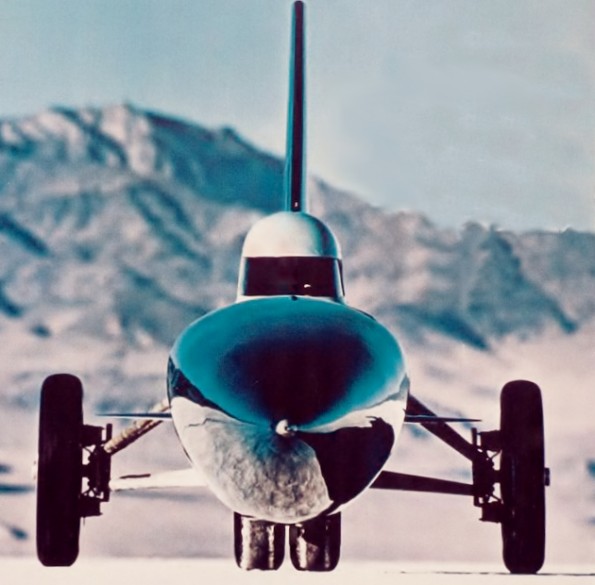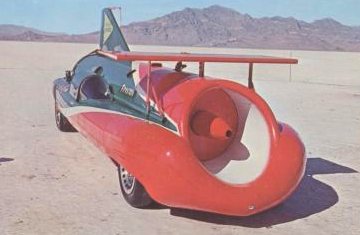The Blue Flame Rocket Car
The quest for a world land speed record perhaps began when Mrs. Karl Benz secretly took the first car for a road trip in 1882. Steam and electric vehicles at first competed with the cantankerous combustion of gasoline engines. High-octane, tetraethyl gas and kerosene-based jet fuels later dominated the records. But in 1970, a sleek blue feat of engineering set the world record of 630 mph. The Blue Flame was powered by liquefied natural gas (LNG).

The Blue Flame makes a spectacular debut at the Bonneville Salt Flats in Utah on October 23, 1970. The natural gas powered rocket car sets a new world land speed record of 630.388 mph.
Why are the most advertised Gold and Silver coins NOT the best way to invest?
Because modern drivers seek environmentally friendly but low-cost transportation fuels, the new abundance of U.S. natural gas supplies promises innovation. Thousands of cars and trucks are now powered by this “fuel of the future.”

The 38-foot Blue Flame’s natural gas-powered rocket motor could produce up to 58,000 horsepower.
Throughout the 20th century, land speed records were set with vehicles powered by steam, electricity, and all manner of petroleum distillates. National pride was often at stake as British, American, French, Belgian, German, and Italian teams fielded competing machines. The first record was set by a Frenchman in 1898. Count Gaston De Chasseloup-Laubat, driving an electric-powered car, achieved 39.24 mph.
Jet Engines rule World Speed Record
After decades of more traditional internal combustion fueled records, mainly by the British, by the 1960s, American innovation – at Utah’s famed Bonneville’s Salt Flats – took mankind’s need for speed to a new level. Jet engines began pushing the land record to previously unthinkable levels.
Jet Propellant 4 (JP-4), the U.S. Air Force’s primary jet fuel until the late 1990s, offered a powerful blend of kerosene and naphtha. On the Bonneville Salt Flats in 1963, the fuel proved to be as good on the ground as it was in the air.
In August of 1963, the Spirit of America, a radical new design created by Craig Breedlove, used a $500 surplus jet engine that burned this kerosene-based JP-4 to run 407.45 mph. Breedlove’s jet-powered machine brought the land speed record back to the United States from England after an absence of more than 30 years.

Natural gas industry funding will provide Dick Keller and his team of engineers vital access to research facilities, including a supersonic wind tunnel.
However, just nine months later, Art Arfons, a drag racer from Ohio, took the land record after clocking 434 mph with his Green Monster using JP-4 in an afterburner-equipped jet engine.
Not to be outdone, Breedlove soon returned to Bonneville with his Spirit of America and pushed to a new record of 526 mph. Arfons, in turn, responded with a run 10 mph faster. And so it went over three years of competition.

Art Arfons’ Green Monster set a land speed record of 434 mph in 1964 – powered by a jet engine.
Breedlove’s Spirit of America Sonic 1 ultimately triumphed over Arfons’ Green Monsters and exceeded 600 mph to set a record that would not be bested until 1970 – when natural gas made its spectacular rocket fuel debut at Bonneville.
Rocket Science: The X-1 Dragster
The Blue Flame sprang from the imaginations of three Milwaukee, Wisconsin, men with a passion for speed: Dick Keller, Ray Dausman and later Pete Farnsworth.

Drag race records set by the X-1 dragster and its 2,500 pounds of thrust rocket motor inspired Dick Keller and Reaction Dynamics to scale up to a 22,500-pound thrust engine using liquefied natural gas (LNG) and hydrogen peroxide to power the Blue Flame’s land speed record attempt.
In the summer of 1964 Keller, employed by the Chicago-based Illinois Institute of Technology Research Institute, became friends with Dausman, who was working on a propellant research contract for NASA. “Around this time, a keen amateur hot rodder called Dick Keller had just got married,” notes a June 2011 article in Octane magazine. “As a condition of accepting his proposal, his new wife insisted he give up drag racing. But he didn’t lose his interest in fast cars.”
The article explains that Keller and Dausman often lunched together. After sharing many “wild engineering ideas” and concepts, “We were scribbling on napkins and stuff – then we thought we would look at a rocket-powered dragster,” Keller is quoted.
The pair designed, built and successfully tested a small, prototype rocket motor giving 25 pounds of thrust. As they prepared a larger version, Keller designed a chassis and “they drafted in part-time hot rod builder Pete Farnsworth to help,” notes the Octane article.
The speed enthusiasts also formed a company called Reaction Dynamics Inc.
In April 1967, their rocket-propelled dragster, the X-1, was complete. Its motor delivered 2,500 pounds of thrust using hydrogen peroxide as the propellant. “This showed well on the drag strips and within a season was outrunning the top-fuelers and jet dragsters,” the article adds.
The post The Blue Flame Rocket Car appeared first on LewRockwell.
Leave a Reply